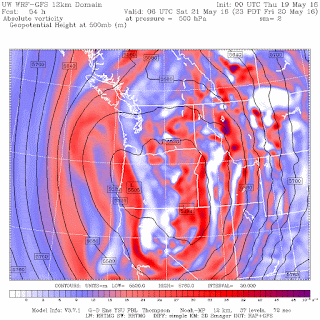But there is another: rain just before harvest that can cause fruit to split. Recently, unusually heavy rain hit California, halving their harvest. Very bad.
Typically, the Washington State cherry harvest starts around June 1st. But with unusually warm weather, the date will probably move up to May 23rd, according to what I have been reading in the Ag magazines. Very soon.
According to the agricultural experts at WSU, when cherries are close to harvest the pressure inside increases. Rain, particularly when the weather is warm, can be absorbed through the outer surface of the cherry (called the cuticle), sometimes leading to the bursting of the cherry. Heavy thunderstorms during warm weather are particularly problematic. Burst cherries may not look great, but are certainly valuable for many uses (juice, jam, etc.). They are less valuable.
Growers have a number of approaches to deal with rain on cherries, including blowers and running helicopters over orchards.
The main rain threat is on Friday/Saturday as the upper low passes south of Washington and precipitation swings northward over eastern Washington, accompanied by easterly (upslope flow)--see upper level (500 hPa) map for Friday at 11 PM.
Since we are very early in the cherry season, only a limited amount of the crop is vulnerable. But orchardists and meteorologists will be watching the situation closely. I certainly will--I love cherries and limited supply can cause the price to rise.










So the cherries are still fine to eat, but people don't want to buy them because the "look" bad? Or are they actually no longer good to eat?
ReplyDeleteI get frustrated with the pressure farmers face to have perfect looking produce. This contributes to the massive food waste here in the US.
Mold can more easily start growing on the cherries where they have split, so it is not just a cosmetic problem.
ReplyDelete@Beth - split cherries are still perfectly fine to eat and are even possibly more tastier. However it is not only "perfect look" issue, they are harder to transport too.
ReplyDeleteBeth, they are fine to eat, it's just that they don't store well because the splits give opportunity for spoilage to set in much earlier after harvest. This therefore makes it harder to get good quality fruit onto the shelves of stores and markets.
ReplyDeleteI don't know what has changed, but I haven't tasted a GREAT cherry in long time. They always look fabulous, but their taste is just...meh. Still expensive too.
ReplyDeleteI don't know if they pick earlier to protect from situations such as this or what but they just don't grow cherries like they used to.
The split fruit is a loss, it has nothing to do with cosmetics. Unless some odd 10 million people descend on the orchards to eat split cherries.. Have NO doubt they are a tragic loss for already poor farmers. Seriously, transport them and they are mush and mold within hours.
ReplyDeleteSure eat them off your back yard tree, but commercial production shipped globally.. NOT!
(Thanks Cliff for educating folks!! Weather anomalies reek Havoc on farmers. We count on you trying your best to give us accurate information.)
@jno62 - If you're buying at a grocery store, chances are you're getting a cultivar that is grown more for its looks and transportability, than for its flavor. Go to your local farmers market over the next few weeks, taste, buy, and ask the farmers which varieties they have. Not all Bing cherries are the same...
ReplyDeleteSeason already started! First washington cherries were on sale today at Duvall farmers market!
ReplyDeleteI really don't give a rip about those orchardists. They sure as heck didn't give a darn about the citizens in the Yakima Valley when they lit those bunker fuel smudge pots back in the 50s an early 60s. Heck with 'em...
ReplyDeleteand, jeez, who knows the pesticides they sprayed their orchards with back in the 50s and 60s...I can still recall the smell 60 years later...
And they sure didn't give much of a damn about the migrant workers that harvested the crops...The Grapes of Wrath depictions fit the Yakima Valley orchardists to a "T" when I lived there...
The GOP still rules in Yakima County....
I sit here at my desk after studying whether or not the blowing I did with a orchard sprayer made any difference in at least getting some of the moisture off the fruit. Going into the night time hours this moisture will sit on the fruit and possibly "soak" into the fruit causing it to crack, or will it? You know it's pretty cold at 55 degrees. If interested in the science of cherry cracking find the Goodfruit grower article that discusses the work done by Moritz Knoche of Institute for Horticultural Production Systems at Leibniz-University in showing that Malic Acid from the first cell to burst from water intake is ultimately responsible for a cascading affect of cells bursting leading to the cherry crack.
ReplyDeleteGood luck, Mark. If you're growing Rainiers, I can't wait to send some dollars your way shortly.
ReplyDelete...As long as there's something to buy...
Monoculture's not always a good bet.
ReplyDeleteWhat Ag magazines are you reading?
ReplyDelete